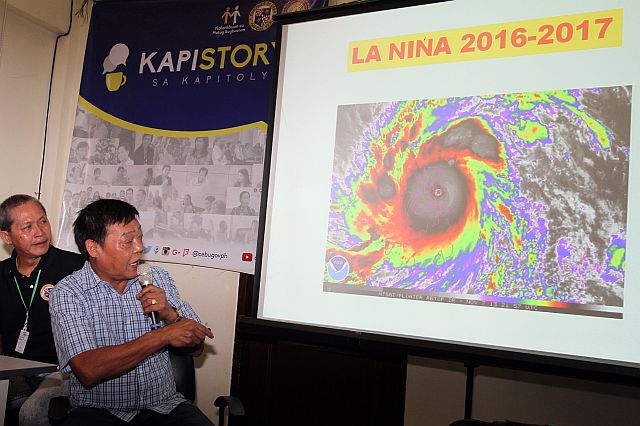
Pagasa Visayas director Oscar Tabada shows a satellite image on the movement of La Niña to local media.
(CDN PHOTO/JUNJIE MENDOZA)
THIS early, Cebu officials and residents were warned to prepare for the rainy season which is seen to be much worse due to the onset of the La Niña phenomenon.
Engr. Oscar Tabada, Visayas chief of the state weather bureau Pagasa, said they expect the rainy season to hit in the third or fourth week of June.
“It may have rained in Cebu province the last few days, but that doesn’t mean the rainy season has started,” he said during the Kapistorya forum yesterday.
Tabada said last year’s rainy season began on June 23.
He said the rainy season starts with the arrival of the southwest monsoon or “habagat” which brings in at least 25 mm of rain in one week.
Tabada also warned about the possibility of another supertyphoon like Yolanda in 2013 due to the La Niña which begins in October this year.
“It is a possibility. Look at Yolanda. It was very hot during the months before it hit. The hotter the weather, the stronger the typhoons that come will get. We should take into consideration that we are expecting more tropical cyclones coming in the second half of the year,” Tabada said.
He said local governments should review local family preparedness programs and intensify their information and education campaign in the grassroots level.
La Niña is characterized by persistent cooler than average sea surface temperature anomalies (below -0.5 degrees Celsius) over the tropical Pacific.
Pagasa said there is a 50 percent chance of La Niña developing in October.
Tabada urged communities to start cleaning rivers, creeks, and canals to prevent floods and landslides in the coming months.
“Floods bring more damage compared to drought,” he said.
Pagasa earlier predicted 19 to 20 tropical cyclones entering the country this year with one to three cyclones to hit in July and two to four cyclones to hit each month from August to October. The first tropical cyclone will be named “Ambo.”
From March to May, Pagasa recorded way below normal rainfall levels or less than 40 percent of the normal rainfall in Cebu during those months.
Pagasa observed 0.30 mm of actual rainfall in March compared to normal levels of 61.0 mm.
They recorded 4.0 mm of rainfall last month or lower than the usual 50.0 mm.
So far they recorded 31.6 mm of rainfall this month compared to the average rate of 100.6 mm.
Tabada said one mm of rain per hour is approximately 5,000 drums of water or 1.04 million liters per hour per square kilometer. He said Cebu will have below normal rainfall levels of 41 to 80 percent despite the onset of the rainy season.
It will experience near normal rainfall levels of 81 to 120 percent from July to October.
Until then, Tabada said they will continue with cloud-seeding to induce rain in the province.